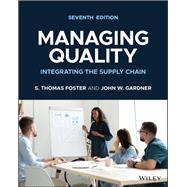In the newly revised seventh edition of Managing Quality: Integrating the Supply Chain, a decorated team of operations experts delivers a thorough introduction to quality management with an enduring emphasis on the importance of the supply chain for quality improvement. You'll obtain an integrated understanding of the customers, suppliers, technology, and people essential to maintaining and enhancing product quality in business.
This latest edition combines the unifying theme of the supply chain with the latest developments in critical subject areas, like Lean, Six Sigma, and service quality. Updated vignettes and references maintain the currency of the work, while new content expands its scope and increases readability and accessibility for students of operations, quality management, and business.








